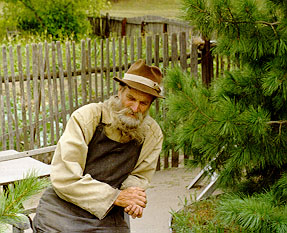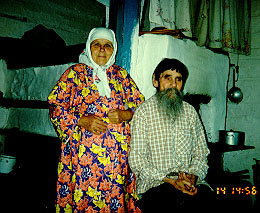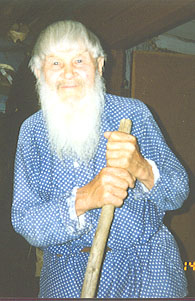ETHNOCULTURAL GROUPS OF RUSSIAN POPULATION
OF ALTAI TERRITORY
by T.K. Scheglova

Population of Altai Territory was formed during colonization of South-western Siberia in the XVIIIth - XXth centuries. In regional historical ethnography it is conditionally divided into two ethnocultural groups: old residents and migrants. The cause of time (60s-80s of the XIXth century) and cultural barrier between the two were specific characteristics of Russian settling the area of Upper Ob and administrative policy of the Cabinet, the owner of Altaian lands. Altai Territory joined Russian empire later than other regions of Siberia (since the end of the first quarter of the XVIIIth century). This and the Cabinet's policy restricting migration to the areat of Altai mining district in the first half of the XIXth century contributed prevalence of colonizing streams from the North of European Russia and Volga area as these regions were free from serfdom. The second migrations from Ural and Siberia played a great role, too. An important driving factor of migrations to Altai was church schism and persecution of old-believers. Significant contribution to formation of primary population was made by the Cossacks.
 The majority of old residents consisted of the first settlers of the XVIIIth century. The components of their culture were formed in conditions of North Russia and White Sea area (Archangelskaia, Olonetskaia, Vologodskaia provinces) - the primary area where colonizing currents were formed, and Ural foothills, Ural (Viatskaia and Permskaia provinces) and Tobolskaia province - the intermediate areas, where migrants from Russia amassed before their next migrations to other Siberian regions. The second source of migrations to Altai asrea was the old-believers population of the middle Volga (Nizhegorodskaia province). Escaping the persecution for following the old faith they fled to Siberia by intricate routes such as across the North and Ural.
The majority of old residents consisted of the first settlers of the XVIIIth century. The components of their culture were formed in conditions of North Russia and White Sea area (Archangelskaia, Olonetskaia, Vologodskaia provinces) - the primary area where colonizing currents were formed, and Ural foothills, Ural (Viatskaia and Permskaia provinces) and Tobolskaia province - the intermediate areas, where migrants from Russia amassed before their next migrations to other Siberian regions. The second source of migrations to Altai asrea was the old-believers population of the middle Volga (Nizhegorodskaia province). Escaping the persecution for following the old faith they fled to Siberia by intricate routes such as across the North and Ural.
 Free from serfdom migrants from the North while adapting to the new environmental conditions worked out principles of living together and communicating, a unique living, household and artistic culture. In process of settling the South of Western Siberia they enhanced themself with the experience of native peoples and became a special ethnocultural group of old resident Siberians with prevalence of North Russia cultural elements with embedded cultural and household traditions of later colonizing currentrs from Volga and South Russia. As a result of this, local ethnographical groups of old residents were formed in the XVIIIth - the first half of the XIXth centuries were in the area of contemporary Altai Territory: Kerzhaks, Chaldons, Pomorians, Viatsky Cossacks, Siberians and others. The ethnic names were identified in two ways: they appeared either as self-given names (Pomorians), or named by local population. The example is the name of an old believers' group of "Poles" that was forced to migrate from Poland in 1775 - 1776 and had South Russian influences in household and culture.
Free from serfdom migrants from the North while adapting to the new environmental conditions worked out principles of living together and communicating, a unique living, household and artistic culture. In process of settling the South of Western Siberia they enhanced themself with the experience of native peoples and became a special ethnocultural group of old resident Siberians with prevalence of North Russia cultural elements with embedded cultural and household traditions of later colonizing currentrs from Volga and South Russia. As a result of this, local ethnographical groups of old residents were formed in the XVIIIth - the first half of the XIXth centuries were in the area of contemporary Altai Territory: Kerzhaks, Chaldons, Pomorians, Viatsky Cossacks, Siberians and others. The ethnic names were identified in two ways: they appeared either as self-given names (Pomorians), or named by local population. The example is the name of an old believers' group of "Poles" that was forced to migrate from Poland in 1775 - 1776 and had South Russian influences in household and culture.
The main areas of old resident settling in Altai Territory were forest-stepp, taiga, foothills and mountain regions. Untill today the old resident population prevails in eastern and central regions. Special role of settling in remote locations belong to old believers who sought ways of keeping the purity of their faith and settled far away from officials and churches. The attractive factors for settling were building material (timber) and land for cultivation and cattle.
The start of formation migrants ethnocultural group was given by the edict issued in 1895 that permitted migration to the area of Altai mining district. However the first wave of general migration from Central Russia and Volga (Voronezhskaia, Kurskaia, Riazanskaia, Tambovskaia, Samarskaia, Saratovskaia provinces) to Altai took place at the end of the XIXth century following the government edicts and regulations of migration to Siberia issued in 1881, 1889 and 1896. The second wave of migrations is associated with reformations of P.A. Stolipin. The majority of migrants came from the southern Russian provinces, left coast of Ukraine and Byelorussia. In Altai they were called "Russeans", "Hohols", "Gomelsky". The primary area of migrants settling were stepp regions of North-West (Kulundinsky Stepp) and South-West of Altai district. The area of integration of old residents and migrants is the central and partially the eastern regions of Altai.
 The majority of old residents consisted of the first settlers of the XVIIIth century. The components of their culture were formed in conditions of North Russia and White Sea area (Archangelskaia, Olonetskaia, Vologodskaia provinces) - the primary area where colonizing currents were formed, and Ural foothills, Ural (Viatskaia and Permskaia provinces) and Tobolskaia province - the intermediate areas, where migrants from Russia amassed before their next migrations to other Siberian regions. The second source of migrations to Altai asrea was the old-believers population of the middle Volga (Nizhegorodskaia province). Escaping the persecution for following the old faith they fled to Siberia by intricate routes such as across the North and Ural.
The majority of old residents consisted of the first settlers of the XVIIIth century. The components of their culture were formed in conditions of North Russia and White Sea area (Archangelskaia, Olonetskaia, Vologodskaia provinces) - the primary area where colonizing currents were formed, and Ural foothills, Ural (Viatskaia and Permskaia provinces) and Tobolskaia province - the intermediate areas, where migrants from Russia amassed before their next migrations to other Siberian regions. The second source of migrations to Altai asrea was the old-believers population of the middle Volga (Nizhegorodskaia province). Escaping the persecution for following the old faith they fled to Siberia by intricate routes such as across the North and Ural.

 Free from serfdom migrants from the North while adapting to the new environmental conditions worked out principles of living together and communicating, a unique living, household and artistic culture. In process of settling the South of Western Siberia they enhanced themself with the experience of native peoples and became a special ethnocultural group of old resident Siberians with prevalence of North Russia cultural elements with embedded cultural and household traditions of later colonizing currentrs from Volga and South Russia. As a result of this, local ethnographical groups of old residents were formed in the XVIIIth - the first half of the XIXth centuries were in the area of contemporary Altai Territory: Kerzhaks, Chaldons, Pomorians, Viatsky Cossacks, Siberians and others. The ethnic names were identified in two ways: they appeared either as self-given names (Pomorians), or named by local population. The example is the name of an old believers' group of "Poles" that was forced to migrate from Poland in 1775 - 1776 and had South Russian influences in household and culture.
Free from serfdom migrants from the North while adapting to the new environmental conditions worked out principles of living together and communicating, a unique living, household and artistic culture. In process of settling the South of Western Siberia they enhanced themself with the experience of native peoples and became a special ethnocultural group of old resident Siberians with prevalence of North Russia cultural elements with embedded cultural and household traditions of later colonizing currentrs from Volga and South Russia. As a result of this, local ethnographical groups of old residents were formed in the XVIIIth - the first half of the XIXth centuries were in the area of contemporary Altai Territory: Kerzhaks, Chaldons, Pomorians, Viatsky Cossacks, Siberians and others. The ethnic names were identified in two ways: they appeared either as self-given names (Pomorians), or named by local population. The example is the name of an old believers' group of "Poles" that was forced to migrate from Poland in 1775 - 1776 and had South Russian influences in household and culture.